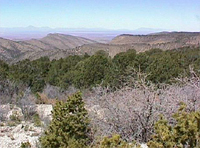|
What part of 1 million comments didn't they understand?
By Kim Todd
 When Sierra Club President Jennifer Ferenstein put a stack of "One-Minute Activist" letters on Forest Service Chief Dale Bosworth's desk, she promised it was merely a down payment. When Sierra Club President Jennifer Ferenstein put a stack of "One-Minute Activist" letters on Forest Service Chief Dale Bosworth's desk, she promised it was merely a down payment.
The letters, clipped, signed and sent by readers of the July/August Planet, demanded that the Forest Service immediately implement the Roadless Area Conservation Rule.
Enacted by former President Clinton before he left office in January, the rule bans logging and roadbuilding on 58.5 million acres of national forest land. Activists are gearing up for another skirmish in the battle for wild forests, in response to the Forest Service's call for still more input on the rule.
Apparently, more than 1 million comments and 600 hearings weren't enough for the Bush administration, which wants the Forest Service to revisit and revise the rule. The 60-day comment period ending Sept. 10 is the first step in this process. Meanwhile, the rule remains tied up in district court in lawsuits brought by the state of Idaho, Boise-Cascade and others.
The Forest Service is seeking responses to 10 questions, many addressing complaints about the rule made by timber companies. One asks, "What is the best way to implement the laws that ensure states, tribes, organizations and private citizens have reasonable access to property they own within inventoried roadless areas?" Another deals with the danger of wildfires.
"There's nothing in the questions they ask that wasn't already considered in the previous, comprehensive process," said Club Wildlands Committee member Laura Hoehn. "Clearly this is just an attempt to revisit issues that have already been decided in order to produce a result that is more favorable to logging and other forms of development."
Rallying people to pick up their pens again is not as hard as one might think, according to Tanya Tolchin, associate representative in Washington, D.C.
"The difference is that now the target is President Bush and his administration's multiple attacks on the environment. People are outraged by what they're seeing, and they want to get involved again," she said.
Hundreds of One-Minute Activist letters from Planet readers have been pouring in to the Club's Washington, D.C., office, some with notes added to the prepared coupon.
The more personal the comments, the better.
Forest Service personnel who counted the previous round of comments categorized them in two ways - as "responses" and "responses and comment," according to Tolchin. A letter or even a preprinted postcard with just a few words penciled in -"preserve grizzly bear habitat" or "I've hiked in the Great Burn, and it's worth saving" - went into a different pile. A letter expressing specific concerns almost always has more weight, she said.
The two main concerns in any revision of the rule are that roadbuilding and logging decisions could revert to individual districts, where timber companies traditionally hold more sway, and that the Tongass National Forest in Alaska would be denied protection.
If the Department of Agriculture decides to draw up a new rule, it will launch a second comment period. This will be followed by a draft environmental impact statement, another round of comments with hearings and a final decision.
But for now, the focus is on this first push for comments and on actions in the Ninth Circuit Court of Appeals.
On behalf of the Sierra Club and other environmental groups, Earthjustice has appealed a district court injunction that blocked the roadbuilding ban from taking effect. Scheduled to be heard before a three-judge panel in October, the appeal challenges arguments by the state of Idaho and Boise-Cascade that the roadless rule process was hasty and inadequate.
"Our contention is that the process was not only sufficient under the law, but that it surpassed all legal requirements," said Timothy Preso, a staff attorney for Earthjustice.
If the injunction is overturned, the rule will take effect immediately. The ongoing lawsuit in district court, which will determine whether the rule stands permanently, probably won't be decided before the new year.
Among all the court dates and administrative procedures, it's important to remember what's at stake, according to Preso.
"It's not the Clinton legacy versus the Bush legacy," he said. "You start talking about 'roadless areas' and it has a bureaucratic quality, but what we're really talking about is the last vestiges of pristine forest land."
Take Action:
Write to Forest Service Chief Dale Bosworth and ask him to let the Roadless Area Conservation Rule stand as written in the January 2001 Record of Decision. Add that the rule should protect the Tongass, and that you oppose forest-by-forest decisions on logging, roadbuilding and other development. According to the Forest Service Web site, you do not need to address the 10 questions, but be sure to add that you are making an official comment on the Advanced Notice of Proposed Rulemaking on Roadless Area Conservation. To see the entire list of questions, go to www. roadless.fs.fed.us/xcomments.shtml.
Write to USDA-Forest Service - CAT, Attention: Roadless ANPR Comments, P.O. Box 221090, Salt Lake City, Utah, 84122; e-mail roadless_anpr@fs.fed.us; fax (801) 296-4090, Attention: Roadless ANPR Comments.
Up to Top
|